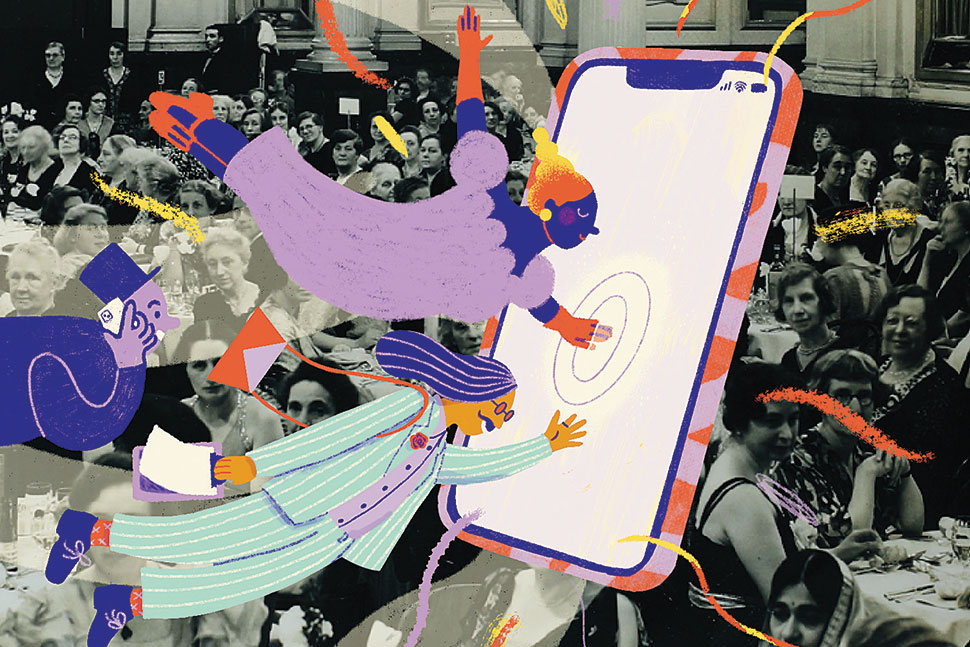
At the onset of the COVID-19 pandemic, Ari Brooks wasn’t sure how to move forward with her library’s fundraising efforts.
In a milieu of uncertainty caused by worldwide shutdowns, Brooks, executive director of Friends of the Library, Montgomery County (FOLMC) in Maryland and a United for Libraries board member, didn’t know if it was insensitive to ask the community to support the library with donations. She attended a workshop in 2020 on fundraising during a crisis, and there she learned a mantra that has anchored her throughout the pandemic: “You have to keep fundraising. You can’t stop. You need to sustain your mission.”
The pandemic has forced Friends groups, foundations, and other fundraising cohorts to adjust their strategies of raising money for their local libraries. Some have had to pause projects or completely scrap ideas. But their creativity and perseverance in the wake of COVID- 19’s many challenges have kept the importance of supporting libraries at the forefront of donors’—and the broader community’s—minds.
‘A screeching halt’
At the beginning of the pandemic, most libraries’ short-term and long-term fundraising projects and programs had to suddenly change. For example, FOLMC owns and operates two donation-run bookstores, which bring in about $900,000 of the $1.5 million it raises annually for the county’s 21 libraries. But when the pandemic hit, those stores closed for 18 months.
“Our large income-generating machine came to a screeching halt,” Brooks says. “Those bookstores [had been] open every single day. So that was scary.” FOLMC instead relied on donations, bequests, grants, and funding from United Way and other philanthropic organizations. These funding streams had supported FOLMC in the past, but for only a portion of its revenue.
FOLMC was also working on a campaign with the Arts and Humanities Council of Montgomery County, a local arts agency and nonprofit organization, to raise funds for a truck that would help collect donations to bring to the bookstore. FOLMC shifted priorities and canceled that fundraiser.
Nationally, larger projects were also sent into flux, including proposals for a new, permanent building for a Cedar Rapids (Iowa) Public Library (CRPL) west side branch and a new outdoor plaza at Santa Barbara (Calif.) Public Library’s (SBPL) Central Library.
In 2008, a flood had left CRPL’s downtown branch unusable and forced library services to move to a kiosk at a mall on the city’s west side until the branch reopened in 2012. During that time, staff noticed high usage of library services there, so the kiosk remained in operation.
Advocating for a permanent west side branch has been the work of the Cedar Rapids Public Library Foundation (CRPLF) and its executive director, Charity Tyler, United for Libraries past president. “The neighborhood had the highest population of children under 5, non-English-speaking individuals, low-income families, [and] single-parent households,” Tyler says. “We knew we couldn’t just walk away.”
Lauren Trujillo, director of the Santa Barbara Public Library Foundation (SBPLF) and a United for Libraries board member, says that when the pandemic began her library was in the process of launching a feasibility study for a new outdoor plaza at SBPL, answering the need for more public space and compliance with the Americans with Disabilities Act (ADA).
“The whole space had poor lighting and wasn’t ADA accessible or stroller accessible—really the antithesis of what a library should be,” Trujillo says. “This was a priority to fix to make the library more welcoming.”
That feasibility study—and planning for the outdoor plaza in general—was pushed to May 2020 so the foundation could focus on more immediate needs, including assisting SBPL in securing $300,000 for a hybrid van to provide mobile services throughout the city.
Moving forward
Seeking a solution, FOLMC designed a new fundraising campaign—alongside the arts council—that Brooks says reminded donors “our mission to support the library’s mission is still relevant.” The new campaign, which was to create a pandemic relief fund, pointed supporters to virtual resources and modified services the library was still providing despite COVID-19’s limitations.
“Libraries were with us before the pandemic, they’ll help us get us through the pandemic, and they’re going to be with us after the pandemic,” Brooks says. The relief fund campaign raised $50,000, according to FOLMC’s fiscal year 2021 report.
When May arrived, SBPLF decided to move forward with its feasibility study. The foundation also sought community feedback on programming that could be done safely outdoors in the proposed space. “During a time where everyone was stuck inside, nobody was opposed to the idea [of the plaza],” Trujillo says. “It seemed like the perfect antidote.”
When the library decided in October 2020 to go ahead with the project, SBPLF campaigned mostly over Zoom, delivering online presentations to members of local government, community leaders, volunteers from previous campaigns, and private donors.
As a result, the campaign raised $5 million in 18 months, with about $1.2 million contributed by the City of Santa Barbara once officials saw the donations that had already been pledged. “It was really about having one-on-one Zoom meetings and painting the picture of what could be,” Trujillo says.
In Cedar Rapids, CRPLF sought funding through the American Rescue Plan Act (ARPA), citing that the new branch would also double as a hub for the library’s existing Opportunity Center—a space where nonprofit organizations can conduct operations—as well as provide social services. Tyler and her team conducted virtual meetings with local government leaders, keeping them informed of the project and advocating for the use of ARPA funds when they became available.
In October 2022, Linn County Board of Supervisors allocated $4 million of the $13 million the county had received in ARPA funds to the new Cedar Rapids library project. The total cost of the building will be about $25 million. “That we got such a great investment from the city was very, very helpful to our project,” Tyler says.
Navigating the virtual landscape
Smaller fundraisers went a long way for public libraries during the pandemic as well, whether groups created new, socially distanced events and programs or adjusted existing ones.
FOLMC helped create take-home book bundles for donors to purchase. CRPLF sold tree saplings, spades, and garden signs not only to fund its Dolly Parton Imagination Library program but also to replant trees lost to an August 2020 derecho, or straight-line windstorm. (For more information on how libraries recovered from natural disasters during the pandemic, turn to “A Perfect Storm,” p. 30.) “We tried to find creative but relevant ways to fundraise that would resonate with donors,” Tyler says.
The virtual landscape provided opportunities for donors to participate in new ways. Each year, many library foundations and Friends groups hold in-person galas for their donors, but galas that were forced to move online were still able to yield results.
In lieu of its recurring fundraiser Booked for the Evening, the Eugene (Ore.) Public Library Foundation (EPLF) hosted a virtual gala called Connecting Community in April 2021. It raised a total of $102,000—including $77,000 from individual donations and $25,000 from a single grant—for a project that would offer free Wi-Fi hotspots for patrons, says former EPLF executive director Reed Davaz McGowan. In comparison, EPLF’s last in-person Booked for the Evening event in October 2018 raised $103,000, says Madison Wilson, EPLF outreach coordinator.
Tompkins County (N.Y.) Public Library’s annual Readathon event, in which community members read snippets of their favorite books and share what the library means to them, moved to a hybrid format for 2022. The in-person component included prerecorded submissions from readers and was livestreamed for donors at home.
“The biggest thing I took away from all of this was the need to build flexibility into everything that we do,” says Kerry Barnes, executive director of Tompkins County Public Library Foundation (TCPLF). “Every single thing that we look at has to have an A scenario, a B scenario, a C scenario.”
Looking ahead
Like many other aspects of librarian-ship, the pandemic has shifted the way fundraising works as the profession defines its new normal.
Though Brooks describes the first few months of the pandemic as the worst of times, she also says that in hindsight, it showed how her team can persevere: “It definitely made us a lot stronger. [The pandemic revealed] that something that could be so horrible could actually create amazingly innovative experiences and [be] such a growth opportunity for my organization and for my team.”
The pandemic also showcased that there is value in meeting virtually. Trujillo notes that Zoom allowed for brevity in the usually long fundraising process, where it’s common to meet multiple times with potential donors and it’s often challenging to hold their focus. “You can spend years meeting with people one-on-one and getting to know them,” she says. “But a positive of Zoom was that they knew we had an hour, and we were able to present and get down to business.”
However, Trujillo also says virtual fundraising may make keeping donors involved long-term more difficult. “We have to look at engagement past the pandemic and make sure that those relationships are fostered as long-term connections to libraries,” she says.
And at times—for example, when virtual fundraising events are recorded for later viewing—Barnes says donors can potentially lose a sense of urgency to attend a library event and therefore lose interest in the cause. She says it has prompted her to rethink the way foundations and donors work together.
“It has required a strong look at what we do,” Barnes says. “Are we doing these things just because we’ve always done them? Or because someone tells us this is how you have to do it? This is an opportunity for us to clear the decks and create a new way of interacting with each other.”
The key to ongoing fundraising in the pandemic landscape, Brooks thinks, may be to keep the mission at the forefront of the community’s mind. “I’ve never worked with as passionate advocates as I have in the library world,” she says. “People really, really, really love their libraries. And as long as we continue to understand the needs of the library system and make that connection to the donor, the donor will always come through.”


